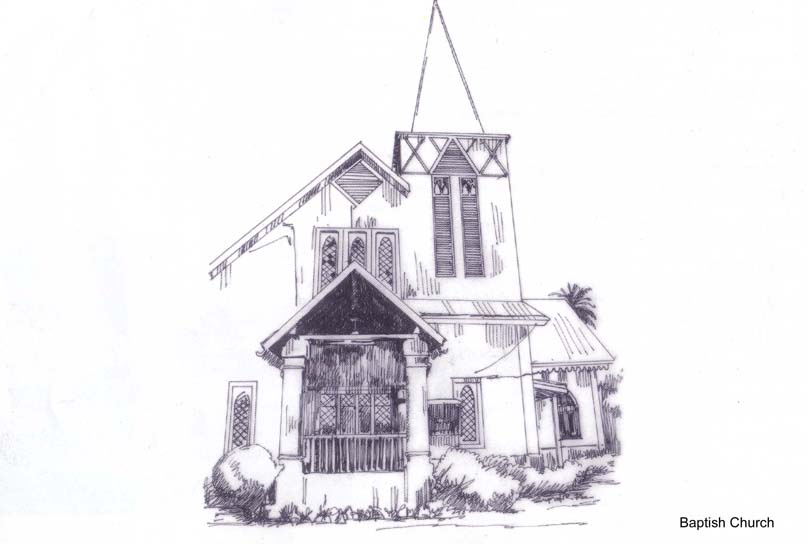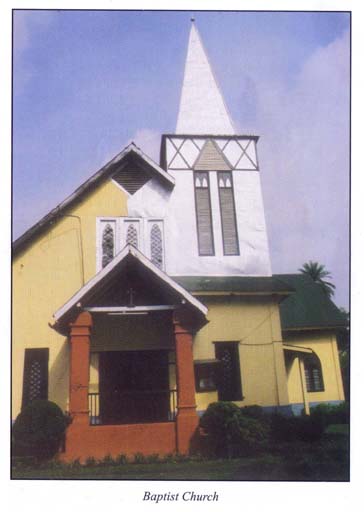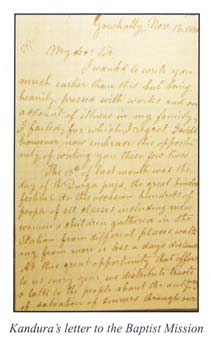| ALMIGHTY’S ABODE |
 |
Albeit it was during the first quarter of the 19th century that the activities of East India Company increased in Assam, it was only after the Treaty of Yandaboo in 1826 that the British began to annex the region in right earnest. This brought British officials and soldiers, who were Christian by faith, to an area where there were no churches and Christian missionary activity was rare. In 1829, at the request of David Scot, the Commissioner of Assam, the British Missionary Society (BMS) started a mission center for Assam. It established its base in Guwahati and James Ray, a young Scot, was appointed to look after it.
|
Ray began well, by opening a school at the center where twelve students were admitted. However, mission work came up against several constraints. So in 1836, when the American Baptist Foreign Mission Society (ABFMS) came to Assam, the BMS donated its land and property in Panbazar to the ABFMS. Thereafter the mission center was expanded, and sometimes prayers were also held in its premises. But it was expanded, and sometimes prayers were also held in it premises. But it was still not a full-fledged church. In facts when Miles Bronson visited Guwahati in 1837, he could not meet any member of any church. |
|
In 1839 the Diocese of Calcutta requested Major Francis Jenkins, the Political Agent to the Governor General in Assam, to take “appropriate measures for the performance of baptism and marriage by public officers”. On January 26, 1845 the representatives of the Christian community in Nagaon, Sibsagar and Guwahati towns, some of who were recent converts to the faith, congregated at Guwahati. Nidhi Levi Farwell, the first Assamese to embrace Christianity, was also present. And in the presence of the assembly was born the first church in the mission complex, also the first Baptist church of the town and one of the earliest in the entire northeastern India.
Cyrus Barker, a missionary, who was to serve the church for the next five years, was appointed its first pastor. Kandura Rollin Smith, a product of the Nagaon Baptist Mission orphanage, became the second pastor. Samuel Loveday and Levi Farwell were the third and fourth pastors. The church began with 30 members, but by the end of the first year itself membership and activities soon made it the core of Christian society. S A D Boggs, a philanthropist, later constructed three beautiful bungalows, among the first in Guwahati, in the premises of the mission. The church also established a letter press in its compound, possibly the first in the town. Some of the textbooks for the schools, prayer songs and gospels were printed in this press.
|
|
The ceaseless efforts of the missionaries did not go in vain. Since the very beginning Bible and Theology classes were regularly held in the church premises. The first Assamese Bible, translation for which was done by Krishna Pal, the first Indian Baptist Christian to visit Assamese carols too began to resonate inside the church. Smith’s was an interesting and blessed life. In 1849 he embraced Christianity and soon became a disciple of the legendary Miles Bronson. He wrote and composed prayer songs, some of which are still very popular among the Christians in Assam. The church was leveled to the ground in the tragic earthquake of June 6, 1897. A new church, a wood structure with tin roof, was built as a temporary arrangement and this structure still stands inside the Mahendra Mohan Chowdhury hospital complex. Meanwhile plans were then chalked out to construct a new building to suit the needs of the times. Two missionaries, G R Campher and A E Stephene took serious initiative in this regard. The Kamarpatty end of the mission premises where the press was situated was selected as the new site. The press was dismantled and the machinery sent to Jorhat. A few Chinese carpenters along with a local Assamese youth named Anandi were engaged for the construction work that was carried out under the personal supervision of G R Campher in 1914. |
After the new church building came up, it became a major attraction for citizens and visitors to the town. Its tin spire rose towards the sky, often catching the sun’s rays. The melodious notes of the church organ hung in the air even as the Brahmaputra flowed by placidly. When its bells chimed, the resonance could be heard for miles around. On
|
sunny afternoons, if one gazed from across the decks of distant ships floating by on the Brahmaputra, the church looked like a lighthouse set on a beam of light. The Guwahati Baptist Church has served as the Mother Church of many churches of the region. The dedicated efforts of its early pastors like Barker and Kandura did not go in vain. Kandura is possibly the first Assamese whose biography The Wonderful Story of Kandura was written way back in 1892 by an American lady called Sofia Bronson Titerington. Published by the American Baptist Publication Society the book is now preserved at the Library of Congress in Washington. Even now, when the devout assemble to offer their prayers at the Cavalry Cross, the symbol of redemptive love, the church continues to echo its great legacy. Its high ceilings, crisscrossed by wooden rafters still keep the summer heat at bay and in its serene ambience one can palpably feel the presence of God. |
 |
.jpg)
